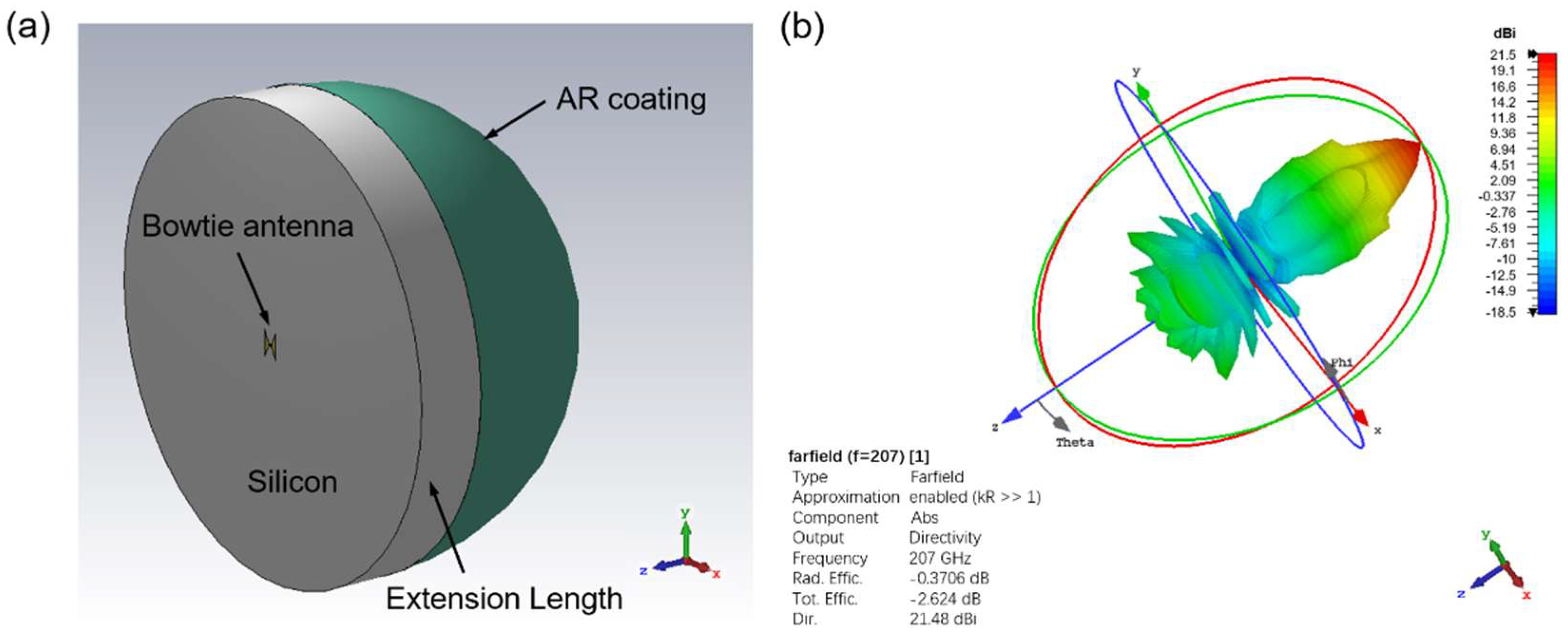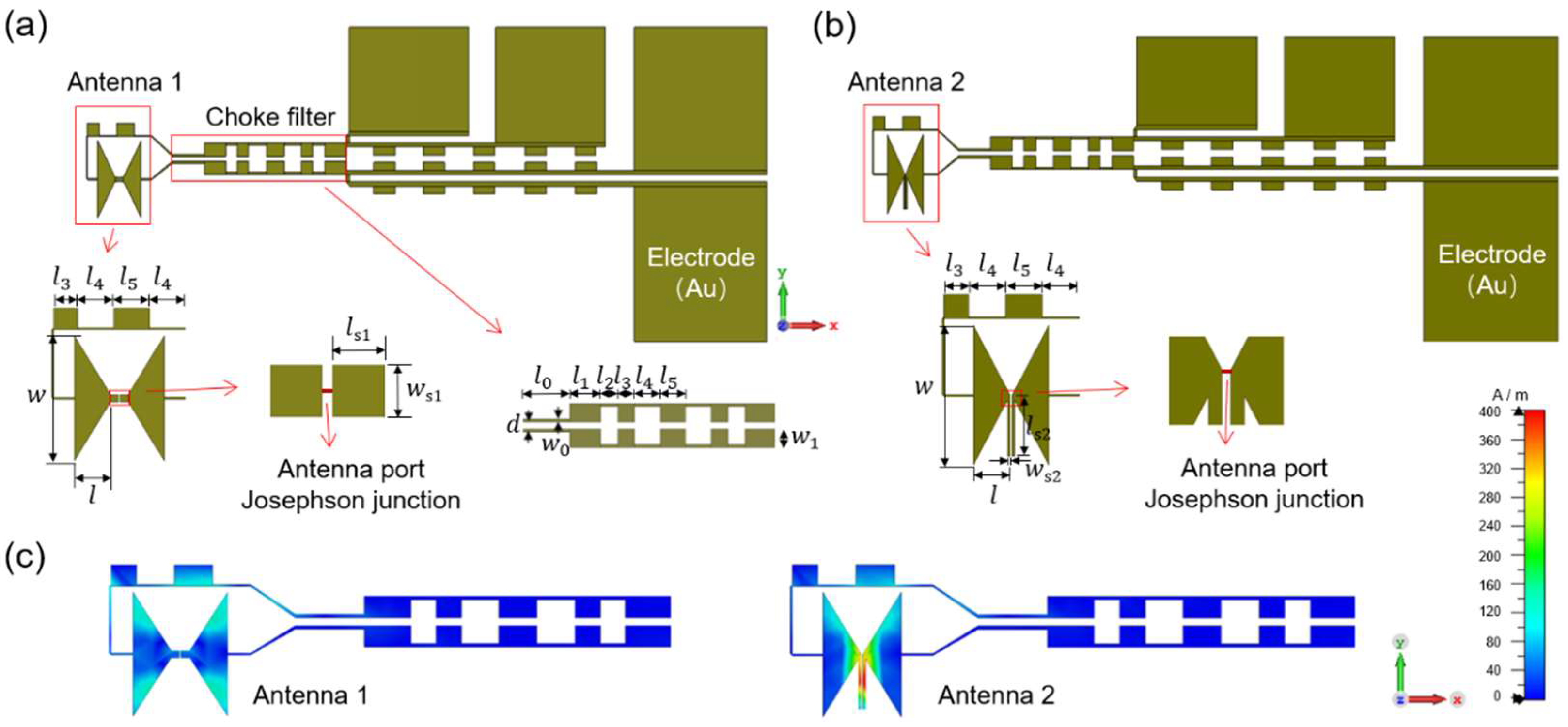High-Tc Superconducting Josephson Junction Harmonic Mixers with Stub Tuners on Integrated Bowtie Antennas
Abstract
:1. Introduction
2. Materials and Methods
2.1. Silicon Lens for Eliminating Thick Substrate Modes
2.2. On-Chip Layout Design
2.3. Fabrication and Experimental Setup
3. Measurement Results
3.1. DC Characteristics and Coupling Power Estimation
3.2. Harmonic Mixing Performance
4. Discussion
5. Conclusions
Author Contributions
Funding
Institutional Review Board Statement
Informed Consent Statement
Data Availability Statement
Acknowledgments
Conflicts of Interest
References
- Yang, Y.; Shutler, A.; Grischkowsky, D. Measurement of the transmission of the atmosphere from 0.2 to 2 THz. Opt. Express 2011, 19, 142266. [Google Scholar] [CrossRef] [PubMed]
- Tong, X.; Li, Q.; An, N.; Wang, W.; Deng, X.; Zhang, L.; Liu, H.; Zeng, J.; Li, Z.; Tang, H.; et al. The study of 0.34 THz monolithically integrated fourth subharmonic mixer using planar Schottky barrier diode. J. Infrared Millim. THz Waves 2015, 36, 1112–1122. [Google Scholar] [CrossRef]
- Leong, K.M.K.H.; Mei, X.; Yoshida, W.H.; Zamora, A.; Padilla, J.G.; Gorospe, B.S.; Nguyen, K.; Deal, W.R. 850 GHz receiver and transmitter front-ends using InP HEMT. IEEE Trans. THz Sci. Technol. 2017, 7, 466–475. [Google Scholar] [CrossRef]
- Khamaisi, B.; Socher, E. 130–320-GHz CMOS harmonic downconverters around and above the cutoff frequency. IEEE Trans. Microw. Theory Technol. 2015, 63, 2275–2288. [Google Scholar] [CrossRef]
- Al-Eryani, J.; Knapp, H.; Kammerer, J.; Aufinger, K.; Li, H.; Maurer, L. Fully integrated single-chip 305–375-GHz transceiver with on-chip antennas in SiGe BiCMOS. IEEE Trans. THz Sci. Technol. 2018, 8, 329–339. [Google Scholar] [CrossRef]
- Virginia Diodes, Inc-Mixers-EHM. Available online: https://www.vadiodes.com/en/products/mixers-shm-ehm-and-fm (accessed on 6 August 2022).
- Chen, J.; Myoren, H.; Nakajima, K.; Yamashita, T. THz mixing properties of YBa2Cu3O7-δ grain boundary Josephson junctions on bicrystal substrates. Phys. C 1997, 293, 288–291. [Google Scholar] [CrossRef]
- Nguyen, T.K.; Ho, T.A.; Han, H.; Park, I. Numerical study of self-complementary antenna characteristics on substrate lenses at terahertz frequency. J. Infrared Millim. Terahertz Waves 2012, 33, 1123–1137. [Google Scholar] [CrossRef]
- Gao, X.; Zhang, T.; Du, J.; Weily, A.R.; Guo, Y.J.; Foley, C.P. A wideband terahertz high-Tc superconducting Josephson-junction mixer: Electromagnetic design, analysis and characterization. Supercond. Sci. Technol. 2017, 30, 095011. [Google Scholar] [CrossRef] [Green Version]
- Gao, X.; Du, J.; Zhang, T.; Guo, Y.J.; Foley, C.P. Experimental investigation of a broadband high-temperature superconducting terahertz mixer operating at temperatures between 40 and 77 K. J. Infrared Millim. THz Waves 2017, 38, 1357–1367. [Google Scholar] [CrossRef]
- Gao, X.; Zhang, T.; Du, J.; Guo, Y.J. Design, modelling and simulation of a monolithic high-Tc superconducting terahertz mixer. Supercond. Sci. Technol. 2018, 31, 115010. [Google Scholar] [CrossRef]
- Ovsyannikov, G.A.; Borisenko, I.V.; Constantinian, K.Y.; Kislinski, Y.V.; Hakhoumian, A.A.; Pogosyan, N.G.; Zakaryan, T.; Pedersen, N.F.; Mygind, J.; Uzunoglu, N.; et al. Bandwidth and noise of submillimeter wave cuprate bicrystal Josephson junction detectors. IEEE Trans. Appl. Supercond. 2005, 15, 533–536. [Google Scholar] [CrossRef]
- Zmuidzinas, J.; Leduc, H.G. Quasi-Optical Slot Antenna SIS Mixer. IEEE Trans. Microw. Theory Technol. 1992, 40, 1797–1804. [Google Scholar] [CrossRef] [Green Version]
- Hasegawa, A.; Uchida, T.; Yasuoka, Y. Slot Antenna Coupled YBa2Cu3O7-δ Josephson Mixers for Millimeter Wave Radiation. Jpn. J. Appl. Phys. 1999, 38, 6670–6673. [Google Scholar] [CrossRef]
- Nakajima, K.; Ebisawa, N.; Sato, H.; Chen, J.; Yamashita, T.; Sawaya, Y. Millimeter-wave sensitivity of YBCO grain boundary Josephson junctions coupled with coplanar waveguide-fed slot dipole antennas. IEEE Trans. Appl. Supercond. 2005, 15, 549–551. [Google Scholar] [CrossRef]
- Gao, X.; Du, J.; Zhang, T.; Guo, Y.J. High-Tc superconducting fourth-harmonic mixer using a dual-band terahertz on-chip antenna of high coupling efficiency. IEEE Trans. THz Sci. Technol. 2019, 9, 55–62. [Google Scholar] [CrossRef]
- Du, J.; Weily, A.R.; Gao, X.; Zhang, T.; Foley, C.P.; Guo, Y.J. HTS step-edge Josephson junction terahertz harmonic mixer. Supercond. Sci. Technol. 2017, 30, 024002. [Google Scholar] [CrossRef]
- Du, J.; Pegrum, C.M.; Gao, X.; Weily, A.R.; Zhang, T.; Guo, Y.J.; Foley, C.P. Harmonic mixing using a HTS step-edge Josephson junction at 0.6 THz frequency. IEEE Trans. Appl. Supercond. 2017, 27, 1500905. [Google Scholar] [CrossRef] [Green Version]
- George, J.; Deepukumar, M.; Aanandan, C.K.; Mohanan, P.; Nair, K.G. New Compact Microstrip Antenna. Electron. Lett. 1996, 32, 508–509. [Google Scholar] [CrossRef]
- Minkevičius, L.; Kašalynas, I.; Seliuta, D.; Tamošiunas, V.; Valušis, G. Frequency-dependent properties of InGaAs bow-tie detectors in terahertz range. Lith. J. Phys. 2010, 50, 173–180. [Google Scholar] [CrossRef] [Green Version]
- Kasalynas, I.; Venckevicius, R.; Seliuta, D.; Grigelionis, I.; Valusis, G. InGaAs-based bow-tie diode for spectroscopic terahertz imaging. J. Appl. Phys. 2011, 110, 114505. [Google Scholar] [CrossRef]
- Minkevicius, L.; Tamosiunas, V.; Kasalynas, I.; Seliuta, D.; Valusis, G.; Lisauskas, A.; Boppel, S.; Roskos, H.G.; Kohler, K. Terahertz heterodyne imaging with InGaAs-based bow-tie diodes. Appl. Phys. Lett. 2011, 99, 131101. [Google Scholar] [CrossRef]
- Venckevičius, R.; Kašalynas, I.; Valušis, G. Bow-tie diodes for terahertz imaging: A comparative study. Photon. Lett. Pol. 2012, 4, 103–105. [Google Scholar]
- Alazemi, A.J.; Yang, H.-H.; Rebeiz, G.M. Double bow-tie slot antennas for wideband millimeter-wave and terahertz applications. IEEE Trans. THz Sci. Technol. 2016, 6, 682–689. [Google Scholar] [CrossRef]
- Rebeiz, G.M. Millimeter-wave and terahertz integrated circuit antennas. Proc. IEEE 1992, 80, 1748–1770. [Google Scholar] [CrossRef]
- Hossain, A.K.M.Z. Planar Antennas for Terahertz Detectors. Master’s Thesis, University of Gavle, Gävle, Sweden, September 2012. [Google Scholar]
- Rutledge, D.B.; Muha, M.S. Imaging antenna arrays. IEEE Trans. Antenna Propag. 1982, 30, 535–540. [Google Scholar] [CrossRef]
- Neikirk, D.P.; Rutledge, D.B.; Muha, M.S.; Park, H.; Yu, C.-X. Far-infrared imaging antenna arrays. Appl. Phys. Lett. 1982, 40, 203–205. [Google Scholar] [CrossRef] [Green Version]
- Grossman, E.N. Lithographic antennas for sub-millimeter and infrared frequencies. In Proceedings of the IEEE International Symposium on Electromagnetic Compatibility, Atlanta, GA, USA, 14–18 August 1995; pp. 102–107. [Google Scholar]
- Krupka, J.; Kaminski, P.; Kozłowski, R.; Surma, B.; Dierlamm, A.; Kwestarz, M. Dielectric properties of semi-insulating silicon at microwave frequencies. Appl. Phys. Lett. 2015, 107, 082105. [Google Scholar] [CrossRef]
- Filipovic, D.F.; Gauthier, G.P.; Raman, S.; Rebeiz, G.M. Off-axis properties of silicon and quartz dielectric lens antennas. IEEE Trans. Antenna Propag. 1997, 45, 760–766. [Google Scholar] [CrossRef]
- Yu, M.; Geng, H.; Hua, T.; Xu, W.; Chen, Z.N. Reactance matching for superconducting YBCO Josephson junction detector using bowtie antenna. In Proceedings of the 2018 IEEE Asia-Pacific Conference on Antennas and Propagation (APCAP), Auckland, New Zealand, 5–8 August 2018. [Google Scholar]
- Yu, M.; Chen, Z.N.; Xu, W.W.; Xu, Y.C.; Geng, H.F.; Hua, T.; Wu, P.H. Impedance matching of bow-tie antenna for high temperature superconducting YBCO Josephson junction mixer. In Proceedings of the 2017 42nd International Conference on Infrared, Millimeter, and Terahertz Waves (IRMMW-THz), Cancun, Mexico, 27 August–1 September 2017. [Google Scholar]
- Ederra, I.; Gonzalo, R.; Martinez, B.; Alderman, B.E.J.; Huggard, P.G.; Murk, A.; Marchand, L.; Maagt, P. Design and test of a 0.5 THz dipole antenna with integrated Schottky diode detector on a high dielectric constant ceramic electromagnetic bandgap substrate. IEEE Trans. THz Sci. Technol. 2013, 3, 584–593. [Google Scholar] [CrossRef]
- Han, K.; Nguyen, T.K.; Park, I.; Han, H. Terahertz Yagi-Uda antenna for high input resistance. J. Infrared Millim. THz Waves 2010, 31, 441–454. [Google Scholar] [CrossRef]
- Zhang, W.; Gao, J.-R.; Hajenius, M.; Miao, W.; Khosropanah, P.; Klapwijk, T.M.; Shi, S.-C. Twin-slot antenna coupled NbN hot electron bolometer mixer at 2.5 THz. IEEE Trans. THz Sci. Technol. 2011, 1, 378–382. [Google Scholar] [CrossRef]
- Shapiro, S. Josephson currents in superconducting tunneling: The effect of microwaves and other observations. Phys. Rev. Lett. 1963, 11, 80–82. [Google Scholar] [CrossRef]
- Du, J.; Hellicar, A.D.; Leslie, K.E.; Nikolic, N.; Hanham, S.M.; Macfarlane, J.C.; Foley, C.P. Towards large scale HTS Josephson detector arrays for THz imaging. Supercond. Sci. Technol. 2013, 26, 115012. [Google Scholar] [CrossRef]
- Auracher, F.; Duzer, T.V. rf impedance of superconducting weak links. J. Appl. Phys. 1973, 44, 848–851. [Google Scholar] [CrossRef]
- Kita, S.; Fujisawa, K. Performances of Josephson Junction Harmonic Mixers with Harmonic Numbers 1–8 at 70 GHz. Jpn. J. Appl. Phys. 1982, 21, 497–503. [Google Scholar] [CrossRef]
- Yu, M.; Geng, H.; Gao, X.; Hua, T.; Chen, W.; Shi, J.; Xu, W.; Chen, Z.N.; Wang, H.; Chen, J.; et al. Grain boundary Josephson junction harmonic mixer coupled with a bowtie loaded meander antenna with zero-bias operation. IEEE Trans. Appl. Supercond. 2019, 29, 1502004. [Google Scholar] [CrossRef]
- Probst, P.; Semenov, A.; Ries, M.; Hoehl, A.; Rieger, P.; Scheuring, A.; Judin, V.; Wünsch, S.; Il’in, K.; Smale, N.; et al. Nonthermal response of YBa2Cu3O7-δ thin films to picosecond THz pulses. Phys. Rev. B 2012, 85, 174511. [Google Scholar] [CrossRef]







| Mixing Parameters | Coupled with Traditional Antennas | ||||
|---|---|---|---|---|---|
| Log-Periodic [41] | Double-Slot [16] | Ring-Slot [17] | Bowtie 1 | ||
| Antenna 1 | Antenna 2 | ||||
| fTHz (GHz) | 207 | 642.24 | 614.4 | 207 | 207 |
| fLO (GHz) | 4.5 | 159.96 | 19.75 | 6.932 | 2.36 |
| fIF (MHz) | 499 | 2400 | 2150 | 944 | 362.2 |
| n | 46 | 4 | 31 | 30 | 88 |
| η (dB) | −71.6 | −18.1 | - | −73.4 | −69.6 |
Publisher’s Note: MDPI stays neutral with regard to jurisdictional claims in published maps and institutional affiliations. |
© 2022 by the authors. Licensee MDPI, Basel, Switzerland. This article is an open access article distributed under the terms and conditions of the Creative Commons Attribution (CC BY) license (https://creativecommons.org/licenses/by/4.0/).
Share and Cite
Yu, M.; Li, C.; Gao, X.; Wang, Z.; Liang, T.-L.; Shi, J.; Shi, J.-X.; Xu, W. High-Tc Superconducting Josephson Junction Harmonic Mixers with Stub Tuners on Integrated Bowtie Antennas. Appl. Sci. 2022, 12, 12813. https://doi.org/10.3390/app122412813
Yu M, Li C, Gao X, Wang Z, Liang T-L, Shi J, Shi J-X, Xu W. High-Tc Superconducting Josephson Junction Harmonic Mixers with Stub Tuners on Integrated Bowtie Antennas. Applied Sciences. 2022; 12(24):12813. https://doi.org/10.3390/app122412813
Chicago/Turabian StyleYu, Mei, Chun Li, Xiang Gao, Zhenguo Wang, Tu-Lu Liang, Jin Shi, Jian-Xin Shi, and Weiwei Xu. 2022. "High-Tc Superconducting Josephson Junction Harmonic Mixers with Stub Tuners on Integrated Bowtie Antennas" Applied Sciences 12, no. 24: 12813. https://doi.org/10.3390/app122412813





